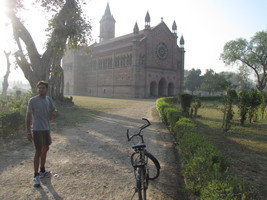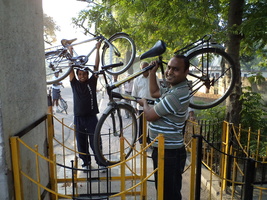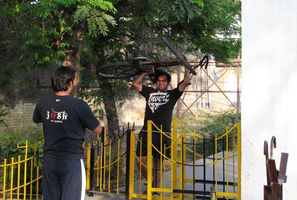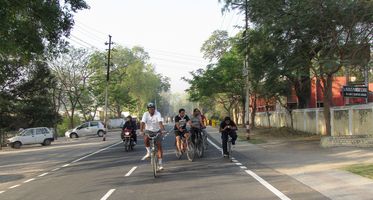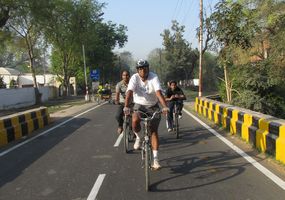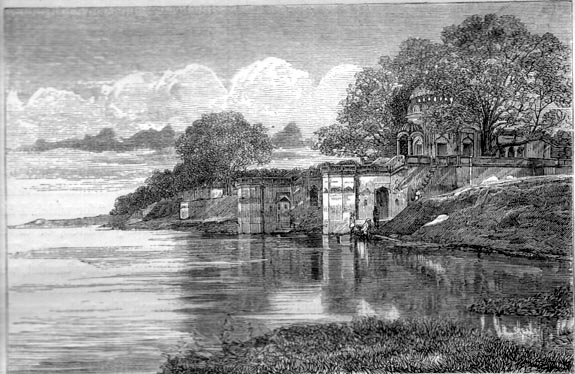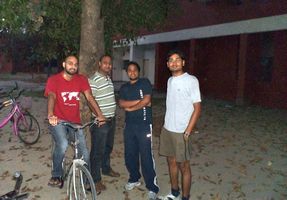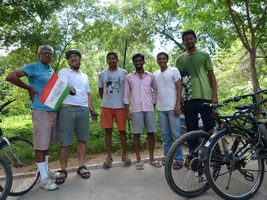we start with a short history of kanpur, which focuses on events such as the insurrection of 1857, which brought kanpur into prominence.
history of kanpur: a survey
kanpur today is largely a legacy of the colonial era. well before the arrival of the east india company, this area was gaining importance as the point on the grand trunk road (connecting delhi and allahabad) where the oudh road (connecting jhansi and lucknow) crossed the ganga. initially it was a boat ferry, and sometimes (in lean months) a bridge of boats over which an army could march across. it may have been located somewhere near the present day railway bridge. by the 1760s, some traders had settled at kanpur, including some portuguese. the first british troops arrived around 1770, and kanpur rapidly became a major garrison town. but kanpur became notorious, at least in british histories, for the brutal events of 1857, during which a few hundred britishers, (half of them women and children), and about a million indians were killed in this area. many of the relics of kanpur date from this insurrection. subsequently, kanpur emerged as a major industrial city, with textile and leather mills employing thousands of people. some of these large mills are still running and are great for historical visits; it is well worth the work in obtaining permissions.pre-colonial history
- 1200bce: archaelogical survey excavations at jajmau TilA have found black and red ware vases that have been radio-carbon dated to 1200-1300 bce.
- upto 3d c. AD: at this one site in jajmau (discovered when the new highway bridge was being dug), there are layers of artifacts going from 1200 bc to the maurya (4th c. BC) and kushAna (1st c. AD) periods.
- 5th c. AD: about 40km from kanpur is the 5th c. gupta period temple at bhitargaon. the area has been continuously inhabited till present times. (see btb page on [bhitargaon].
- 1700s: "the only building of any consequence" when the British arrived, was a palace of Raja Hindu Singh Chandel (Zoe Yalland). The Raja had founded the village, legend had it, as an act of penance and to honour Krishna (kanha + pur = Kanhapur -> Kanpur). [Spectre of Violence by Rudrangshu Mukherjee, p.6]
- 1750s: kanpur is a minor trading post, with a few private european traders were in residence by the 1760s. the present-day katchery cemetery is still sometimes called the portuguese cemetery.
british presence (east india company)
background: the east india company, in need of greater revenues in bihar, defeated the forces of awadh and delhi at the battle of buxar in 1764. in 1765, the mughal emperor shah alam granted the company the diwAni or governorship of bengal (which included bihar and extended till varanasi). subsequently, they started eyeing the rich lands of awadh. small 'rebellions' would be put down, and some lands annexed each time by the company. eventually, in 1856, the nawabs were de-throned on charges of poor administration. the next year, the rebellion erupted.- 2 feb 1770: first company troops arrive. capt robert brooke leads british troops into kanpur, chasing a maratha incursion. he leaves "two companies in the line and proceeded immediately against the first zemindar who had rebelled." [Rudrangshu Mukherjee, Spectre of Violence: The 1857 Kanpur Massacres]
- 1773: the company signs the treaty of banaras with shuja-ud-daula of awadh, who pays them for helping awadh militarily against the marathas and the rohillas.
- 1775: shuja dies, and the company decides that the earlier treaty had been personal. the treaty of Faizabad (fyzabad) is forced on his heir asaf-ud-daula. troops are to be maintained in awadh, including kanpur, for which the nawab is to pay rs. 2.6 lakh per month.
- 1776: East India Co. opens an agency office in Kanpur.
- 1778: 12 villages taken over for maintaining the cantonment, including a village called kanpur (possibly the "old kanpur" area near present day azadnagar).
- 1790: what is possibly the first indian novel, nashtAr (in persian), is written in kanpur. (english tr. dancing girl, Q. Hyder, 1993) shows british company officers of the time conversing in persian and hindustani, to the extent of being able to understand hafiz lyrics sung at nautch performances (persian was the official language of business for the company till 1835). the novel makes several references to jajmau, which was an elite area with large bungalows overlooking the river.
- 1801: lord wellesley truncates the kingdom of awadh; seven districts including kanpur shifted to the east india company.
- 1802: abraham welland appointed as magistrate of newly formed kanpur district. his bungalow combines living quarters, cutcherry (court room), treasury, locking cell, and a record room. [spectre, p.10]
the 1857 insurrection
background: the history of the 1857 insurrection has emerged as one of the most fiercely contested aspects in the postcolonial register. for over a century, a large body of serious history as well as vulgate fiction has "operated according to a dominant interpretation", a pattern enforced without "explicit censorship or any conscious plot to deceive". [from the persuasive analysis of vulgate fiction on the mutiny and its relations to the histories by Gautam Chakravarty: The Indian mutiny and the British imagination, 2005). documents violating this dominant interpretation were ignored (e.g. Edward Leckey's close textual analysis revealing contradictions and absurdities in several "eye-witness accounts", Maude's statement that Nana may not have been guilty of Bibi-ghar). the name of the event itself (mutiny? war of independence? sepoy war? uprising? rebellion?) is contested. while some of the initial events involved sepoys whose acts may be called a "mutiny", postcolonial historians have convincingly argued that the involvement of the landed gentry and other irregulars, and also the essentially peasant background of the sepoys speak of a broader social structure for the insurrecction. also causes for the mutiny were far deeper than the cartridges greased with beef and pork; indeed the very fact that such cartridges were introduced at all is indicative of the extent to which the officialdom was disconnected from the populace. s.n. sen has observed that in 1857, the east india company was operating as one of the agents of the mughal emperor bahadur shah. thus, when the sepoys at meerut turned their allegiance to the emperor, whether this constituted "mutiny" is debatable since the east india company was formally a vassal to bahadur shah.- 1830s: local landlords are increasingly disenfranchised on various pretexts. severe measures adopted for tax collection. process accelerates after dalhousie's doctrine of lapse (1848-56).
- 1856: kingdom of awadh annexed by dalhousie and the nawab is exiled to metiabruz, calcutta. most of the sepoys are from awadh.
- 1856 dec: enfield cartridges greased by tallow are introduced in india at barrackpur, meerut and ambala. a firm in calcutta is tendered to supply "tallow grease" (madeof beef and pork fat).
- 1857 mar: mangal pandey incident at barrackpur
- 10 may, 1857: meerut uprising on 10 may. delhi falls on 11 may. lucknow ignites on may 30.
- 1857 jun 5: the sepoys in kanpur rebel. they loot the treasury, and without harming anyone in kanpur, start marching to delhi to join the emperor.
- jun 5 night: after a day's march, they rest at kalyanpur (near IIT). it seems azimullah and perhaps also the nana, come down from bithoor (meeting near the kalyanpur junction) and talk to them. in the morning they return to kanpur.
- jun 6-26: the kanpur garrison, commanded by the widely respected Gen. Hugh Wheeler, is not expecting an attack. they are at a make-shift entrenchment at the present-day location of the memorial church. june 6, nana writes wheeler warning him of the attack, which commences the next morning. they remain besieged from june 7 to 26, facing severe crises of rations, water, and medical supplies.
- jun 11, Allahabad: Col Neill arrives in Allahabad, where the mutiny of 6 june has
been crushed. there is scarcely a tree without a dead body hanging from it:
For three months did eight dead-carts daily go their rounds from sunrise to sunset, to take down the corpses which hung at the cross-roads and market-places, poisoning the air of the city, and to throw their loathsome burdens into the Ganges. - Travels of a Hindoo by bholanath chandra, p.324]
- jun 25, kanpur: nana sends wheeler an offer to surrender on terms of safe passage by boat, which after some modification, is accepted the next day.
- jun 27, 7 AM: 16 elephants and 70-80 palanquins arrive to convey the british to sati-chaura ghat. here, about 40 boats are made ready. the sepoys are courteous to their erstwhile officers. at the ghats, the late-summer river is silted up and it is hard to launch the boats. a large crowd has gathered and there is considerable tension in the air.
- jun 27, 9AM: the most detailed eye-witness account
is from capt. mowbray thomson. the banks are lined with natives.
the boatsmen are finding it very difficult to launch the
boats. communication is difficult, and
nerves are
frayed. Thomson
writes:
when all were aboard, we were to push off as quickly as possible, and make for the other side of the river... but at a signal from the shore, the native boatmen, who numbered eight and a coxswain to each boat, all jumped over and waded to the shore. We fired into them immediately but the majority of them escaped...
some indian historians have argued that it may have been this initial british firing that caused a reaction firing from the wound-up sepoy troops (a cavalry unit was the first to fire back). this led to others joining in, and in the end, the exposed britishers on their stranded boats were all killed by firing from shore. but some guns had definitely been placed along the shore, and some boatmen deposed that they had set fire to the thatch of one boat. so while there is some evidence of mischief, it is difficult to attribute it to a central plan executed by Nana (FC Maude, Memories of the mutiny, v.1 p. 108). for a century after the event, the ghat was called "massacre ghat". the name persists though it is officially the "nana rao ghat" today. - jun 27, noon: when the smoke clears, about 200 women and children are alive. one boat has escaped; eventually, only four britishers survive. the following day, the nana crowns himself as peshwa.
- jun 30: relief column under major renaud leaves allahabad for kanpur, meting out severe reprisals to all natives on the route . "Renaud was rather inclined to hang _all_ black creation", [british officer quoted in Spectre, p.240]
- jul 15: the relieving army, now headed by the experienced general havelock, is at maharajpur, 15km from kanpur.
- jul 15, night: the nearly 200 british women and children at bibighar, are killed by butchers on order of a woman called "the begum". later investigations reveal that sepoys had refused to shoot them. their bodies are dumped into a nearby well. it is possible that this barbaric act may have had something to do with the barbarism being inflicted on their kith and kin in the villages: "It is not far-fetched to imagine that the news of British atrocities reached the rebel stronghold in Kanpur." [spectre, p.73]
- jul 16: kanpur falls to havelock's army. the discovery of the killing of the women and children and the ignites a century of anguish in england, so that "cawnpore" and "nana" become deep-seated pejorative terms in the british lexicon
- jul 17-aug: british vengeance is fierce. "the Deputy Commissioner of the Punjab, Francis Cooper, summarily executed nearly five hundred unarmed mutineers (who had surrendered believing there would be a court martial) ... at Ajnala on 30–31 July, upon which he announced vengefully: ‘There is a well at Kanpur, but there is also one at Ujnalla.’" (from chakravarty). the total indian deaths in Awadh after 1857 are thought to be about 1.5 lakh [Bipin Chandra] (this number is estimated variously between 0.15 and 15 million). The population of Awadh, about 100 million at the time, was down to 84mn in the 1872 census. there were 20 lakh letters in the GPO in lucknow for which the addressee is missing. - Amaresh Misra
- 1858: a statue and a screen is erected on the site of the well at bibighar (present day phool bagh). Around the mid-1950s, these are shifted to the memorial church.
An Englishman is almost suffocated with indignation when he reads that Mrs. Chambers or Miss Jennings was hacked to death by a dusky ruffian; but in Native histories, or, history being wanting, in Native legends and traditions, it may be recorded against our people, that mothers and wives and children, with less familiar names, fell miserable victims to the first swoop of English vengeance; and these stories may have as deep a pathos as any that rend our own hearts. It may be, too, that the plea of provocation, which invests the most sanguinary acts of the white man in this deadly struggle with the attributes of righteous retribution is not wholly to be rejected when urged in extenuation of the worst deeds of those who have never known Christian teaching.
historical sites at kanpur
The map below takes one full day (7AM - dusk) from iit kanpur and covers about 60 km.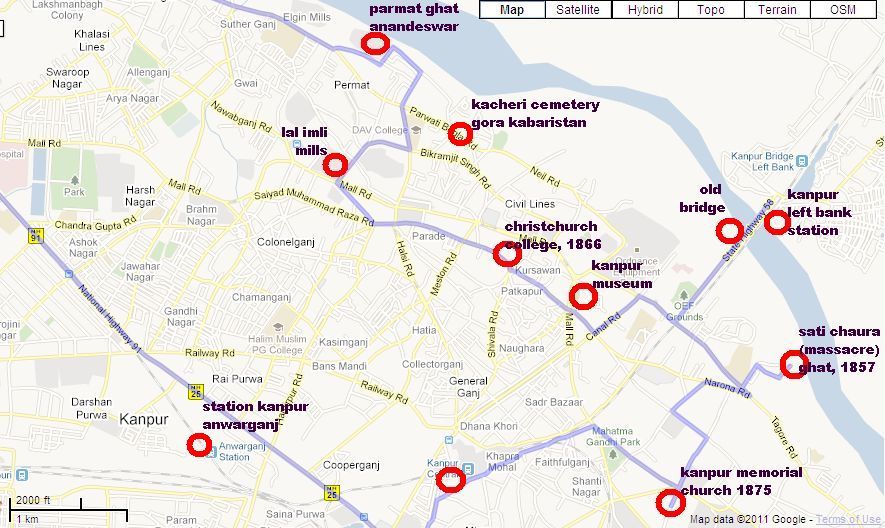
1. kanpur anwarganj and kanpur central (railway history).
2. all soul's church,
3. nana rao ghat (called "massacre ghat" in british times). also called sati
chaura ghat, which is technically a bit upstream,
4. old kanpur bridge,
5. kanpur museum at phool bagh,
6. christ church (the church, not the college)
7. gora kabaristan (katchery cemetery, old portuguese cemetery),
8. lal imli and elgin mills (industrial era)
9. parmat ghat.
Sites not on map:
10. old cawnpore station (off gt road),
11. old kanpur (near azadnagar),
12. cs azad agriculture university and hbti (to the West).
sites from kanpur railway history
[this railway segment of the tour owes much to veteran railway buff joydeep dutta]. the first railway of north india opened from allahabad to kanpur in March 3 1859. this first single-platform station is lost - somewhere in the freight yard according to joydeep. the present kanpur central was built from 1928-1930.1. kanpur anwarganj station
the kanpur farrukhabad line opened 1880, but the anwarganj station was built in 1896. these were built by the indian branch railway co, which built branch lines (kanpur-lucknow 1867), and became part of the oudh and rohilakhand railway.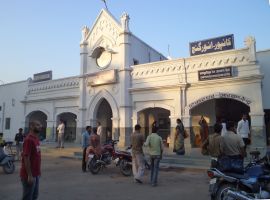
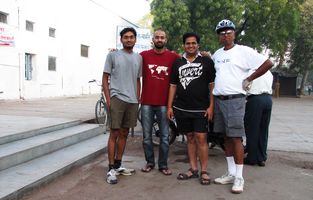
the station facade. prince, sayyed, vishal and amit
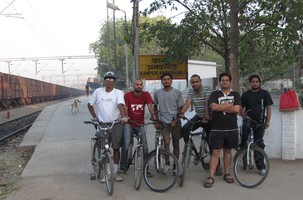
at the end of the kanpur anwarganj platform. amit,sayyed, prince, sudip, vishal and anup.
anwarganj station train controller explaining the system
10. old kanpur railway station
this station is on the direct line from howrah to delhi (still used by goods trains). passenger trains go on a loop to reach the present kanpur central. the station was most likely built around 1880 and remained in service till 1930. by the 1920s, at which point traffic gradually shifted to the Cawnpore Barracks station (which is why the code for kanpur is "CNB" - J. Dutta). 1928-1930, the "Kanpur Central" station was built at the Barracks location. Eventually, operations ceased at the old cawnpore station c.1930. Today it is a railway training institute.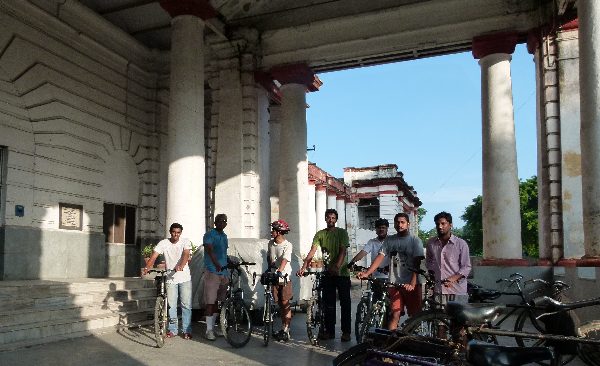
old cawnpore station with its elegant portico (manoj amit saumyen karthik joydeep arunkb babu).
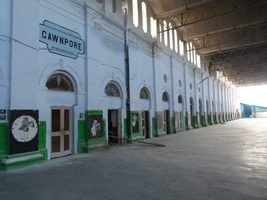
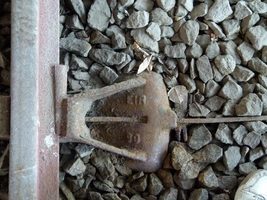
cawnpore station platform. the marble tablet on the wall declares: "from calcutta 632 miles 962 to bombay. 414 feet above sea level." a railway sleeper from the time of the East India Railway (E.I.R.).
mutiny relics: cantonment area
to reach the cantonment area (the old military area) from the mall road, you can try crossing this gate. bicycles are permitted on both sides, but the barrier is kept to prevent motorcycles, presumably. so they told us that we should lift up the cycles and proceed... the more i bicycle around, the more i realize that our real challenge is to prevent motorcycles from encroaching on paths meant for bicycles.2. all soul's church (erstwhile "kanpur memorial church")
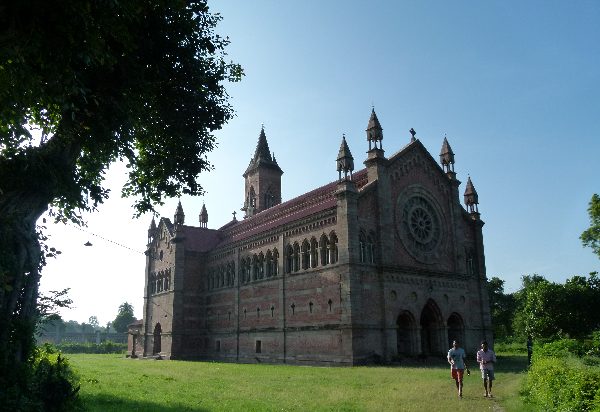
kanpur memorial church (all soul's church). built 1875 the memorial church is in cantt, 16km from iitk. it is now called the "all soul's church", a term that does not ask who it is a "memorial" for. we met the presbyter, mr carroll - he is pleased to see that we'd come all this way by cycle. the church was built in 1875 in the memory of the british who had died in the mutiny, and was for long known as kanpur memorial church. the presbyter told us that "today, it is no longer 'kanpur memorial church but only 'all souls church'". the compound has an amazingly large number of aggressive street dogs. the presbyter called them his "chowkidars". unfortunately the church was closed - it would open for a service at 9 am but we couldn't wait that long. dont forget to check out the forgotten angel in the south face.
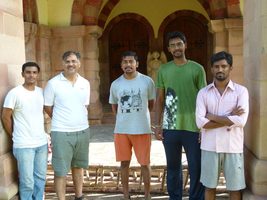
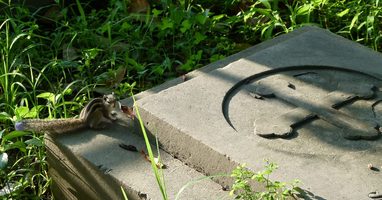
lined up before the winged angel: manoj joydeep arun karthik babu. a squirrel scuttles around where once cannonballs whizzed. meanwhile contested histories are emerging from old graves...
the memorial church was built in 1875, on the site of the famous wheeler's entrenchment, where a few hundred britishers and anglo-indians led by gen. hugh wheeler had holed up against sepoy troops, from june 6 to 26, 1857. [e.g. see G.O. Trevelyan, Cawnpore, 1865; a well-documented history of the British view.) the area that was "wheeler's entrenchment" is now gone, and the nearby racecourse is now a civil aerodrome. the present church compound was certainly part of it. there are a number of other old british era building in the vicinity. the cawnpore club (which retains the raj spelling) has some parts (a reading room) that dates from the 1830s. several other churches in the area - st johns, etc. are much older. all soul's is the baby among the churches, said mr. carroll.
3. nana rao ghat (massacre ghat)
historyupon the promise of safe conduct, the garrison under wheeler surrendered on june 27 1857. they were provided coaches and elephants to proceed to the ganga, from where they would go by boat to allahabad. their fateful route went more or less along the roads we followed to the nana rao ghat. here the water was running low (it was late june, pre-monsoon) and at one point some indian boatmen who were helping them launch the boats suddenly jumped off and made for the shore. there was some misunderstanding, and Mowbray Thompson, one of the survivors wrote in an early report that at this point
As soon as Major Vibart had stepped into his boat, "Off" was the word; but at a signal from the shore the native boatmen, who numbered eight and a coxswain to each boat, all jumped over and waded to the shore. We fired into them immediately, but the majority of them escaped. ...rudrangshu mukherjee quotes this statement to indicate that it is possible that the british may have been the first to start firing, leading to large-scale return of fire from the massed sepoys. other survivor reports talk of the firing starting up, but do not discuss who started it. a very long and loud british tradition has it that it was all planned by nana rao, that the cavalry swept into the water and killed off the remaining few. the british colonial sentiment, fueled by "mass market novels filled with lurid accounts of rape and mutilation that threatened the ‘purity’ of British womanhood" [Metcalf/Metcalf, p. 106], overwhelmingly painted a despicable picture of natives and fueled british racism for many decades. as for rape and british womenhood, over the twenty day captivity of 200 british women and children at kanpur, there was no evidence of rape. by in any event, this is the ghat that evoked lurid fascination for several generations of englishmen. certainly, some 200 britishers and an unknown number of indians died here on june 27, 1857. looking down the ghat, i thought of how their bodies may have floated down the ganges next to each other; had there been some of this closeness earlier, all these deaths could have been avoided.
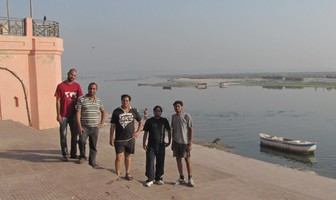
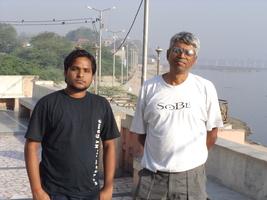
at nana rao ghat. sayyed, sudip, vishal, anup and prince. R: anup and amit. behind us are the long sati chaura ghat, beside the sati chaura village.
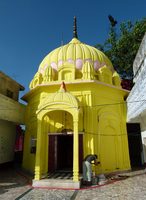
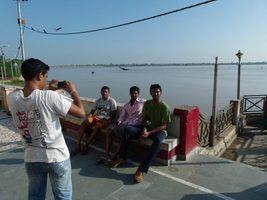
yellow temple at nana rao ghat. photo session: manoj clicking arun, babu and karthik.
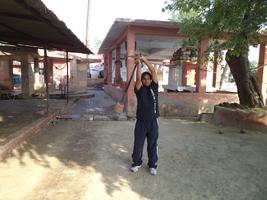
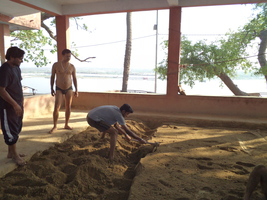
outside the nana rao ghat we found this akhara - it has been running since the early 1900s. prince trying his hand at exercise by digging, and anup swirling the mace.
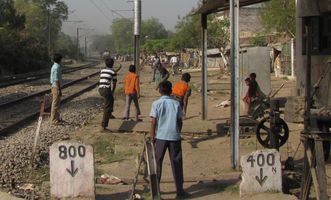
crossing the kanpur-lucknow line, there was a train coming. but it didn't prevent these kids from continuing with their cricket.
5. kanpur museum (KEM Hall) and phool bagh (bibighar)
and then the kanpur museum in phoolbagh (started in 1880 as the king edward memorial hall, now the ganesh vidyarthi hall). like many bridges of the period, the truss structure below the main carriageway is also used as a road. today, the upper deck is what most people use - lower deck access can be closed off by two doors. as of today, there were bamboo barriers at both ends to stave off motorcycles.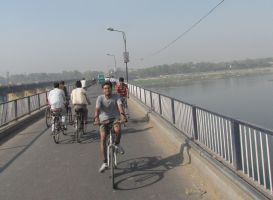
prince
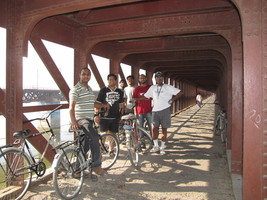
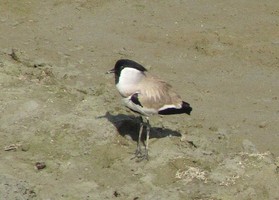
posing for a photo in the underdeck. a river lapwing vanellus duvaucelii, from the sand bank below.
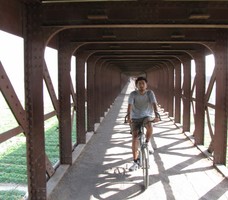
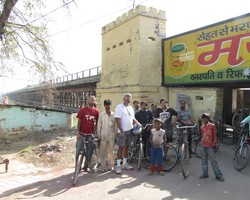
prince - riding on the lower-story of the bridge. here you can see the bridge structure; the trusses underneath and the road above.
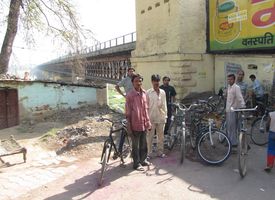
i had crossed back under the bridge ahead of the group. i thought this was a good spot for a photo. so i said "idhar aao for a photo" to the others behind me. then these two passersby who had just crossed over came and stood in line. one of them remained standing throughout the shot. i wondered why having a lot of free time is associated with low self-esteem...
6. Christchurch; 12. CSA University, HBTI
we next visited christ church (1830) where there was a beautiful service that we were just in time for. the parade grounds next to this church were where a indian prisoners and rebels were often fired off from canons. one witness wrote: "perhaps six to eight seconds after the explosion, down fell the man's head among us, slightly blackened but otherwise scarcely changed." next we went to the kacheri (gorA) cemetery with graves from 1790 to 1870s (the first british settlement at kanpur started in 1770s)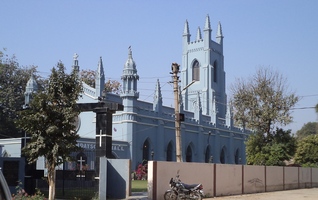
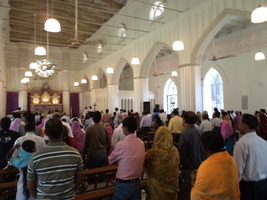
the church at Christchurch; sunday mass.
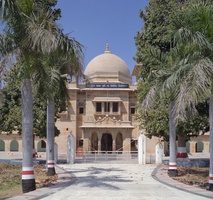
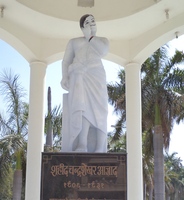
domed kailash bhavan at CSAU. Statue of Chandrasekhar Azad.
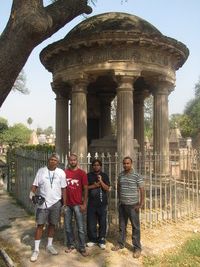
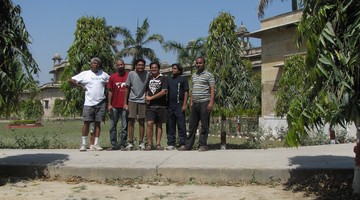
At the cemetery: Amit, Sayyed, Anup Sudip. At CSA University of Agriculture: Prince, Vishal, Anup, Sudip.
